
Minimum Viable Product (MVP): What Is It And How To Build One?
Building a successful product – whether it’s a cutting-edge mobile app or a revolutionary SaaS – should always begin with a critical step: creating a minimum viable product (MVP).
The importance of MVPs cannot be overstated.
It can save online entrepreneurs from wasting valuable resources and help SaaS owners attract outside funding.
Join us as we uncover the secrets behind this invaluable product development strategy and learn how you can build your own MVP faster and more efficiently in Openkoda. You don’t want to miss this!
What is MVP? Minimum viable product definition
Imagine you have a great business idea. Something that has huge potential if done right.
There’s just one little problem.
How can you test your product hypothesis on your target audience and convince investors to invest in your company with the least amount of effort?
Enter minimum viable products.
A minimum viable product (MVP) is a fundamental concept in product development and entrepreneurship. With proof of concept (POC) they are the simplest, first versions of a new product or digital service that can be built to test the core product ideas and gather user feedback. The primary goal of an MVP is to minimize time and resources while maximizing learning. By releasing an MVP, entrepreneurs and product teams can quickly assess whether their business ideas resonate with users and whether their product truly solves a real problem.
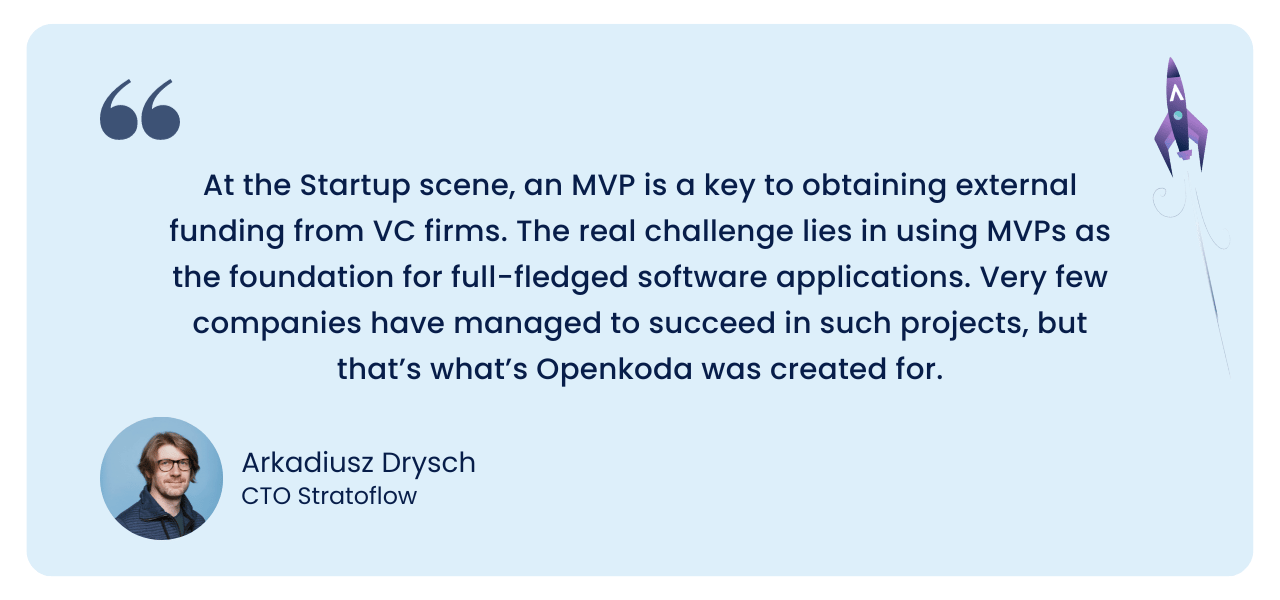
What’s the purpose of minimum viable products?
By now we see what the main concept behind minimum viable products is.
But why bother with the MVP concept at the first place?
Wouldn’t it be easier to just start developing the product and use some kind of beta version to test user acceptance?
The software development process is not that simple.
Custom software projects often require significant time and resources, and without a well-defined strategy, and tested market fit there’s a significant risk of investing in a product that doesn’t meet end-user and market needs.
An MVP serves as a strategic compass. It involves creating a basic, functional version of the software with only the core features needed to solve the most pressing problems of the target audience. The primary goal of an MVP is to develop a prototype of the final product that focuses only on the key functionalities-those aspects of the final application that will deliver the desired value proposition to end customers.
That’s why the primary goal of minimum viable products (MVPs) is to mitigate risk and maximize the chances of building a successful product bye testing its product market fit.
By launching this minimal version early in the development cycle, developers and stakeholders can gather a maximum amount of critical customer feedback and validate the business idea. This iterative feedback loop not only helps refine the software, but also minimizes the potential for costly development errors and wasted resources. In essence, MVPs are an indispensable tool in custom software development, ensuring that the final product is not only functional, but also precisely tailored to user needs and market realities.

Minimum viable product example
To better understand the importance of MVPs in software development, let’s consider an example.
A simple social media application.
Instead of launching it with a full suite of complex features such as messaging, video uploads, and advanced filters, a team of developers decides to launch an MVP of this app-an early prototype that offers only user registration, profile creation, and basic posting capabilities.
This simplified version is created with enough features to allow the developers to gauge user interest, gather feedback, and validate the concept of the app.
With an MVP of such an app, the product team can validate its product idea early without fully committing to the complex and resource-intensive software development process. If users find value in these core features, the team can then invest more time and resources in extending the app with additional features based on user feedback. In essence, the MVP approach allows teams to validate their assumptions and efficiently iterate on their product.
[Read also: The Complete Guide to Software Outsourcing: How to Make it Work for Your Business]
The importance of MVPs for modern businesses
Let’s face the truth – most start-ups fail.
In fact, according to Harvard Business Review, more than two-thirds of startups never deliver a positive return to investors.
So what’s the root cause of their rather disappointing end?
Well, there can be a plethora of various things from inadequate marketing to issues with the company’s cash flow, but more often there have been issues with proper product validation at play.
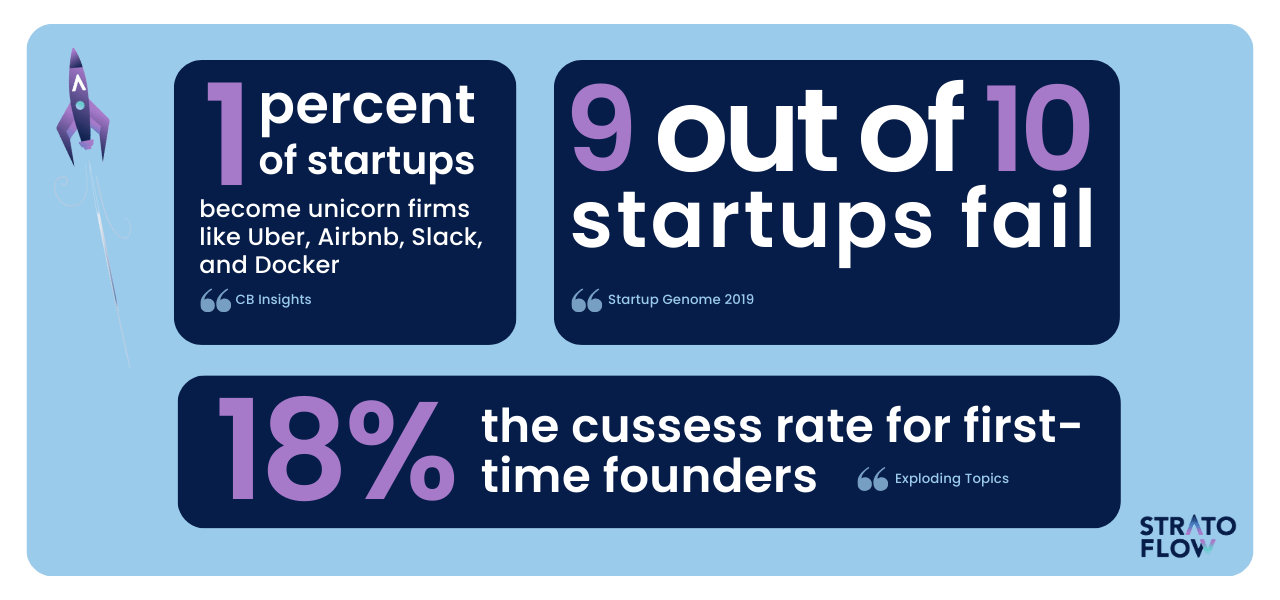
According to CBInsights the two main causes of startup bankruptcy are:
- Inability to raise sufficient capital
- Lack of market need
What do both of these factors have in common?
Both can be solved by starting software development with a solid minimum viable product (MVP).
By demonstrating a working model or prototype, entrepreneurs can attract potential investors and secure funding more effectively because MVPs reduce the perceived risk associated with the project.
In addition, MVPs allow companies to test their product or idea with a select group of users in the target market prior to full-scale development. This early feedback enables adjustments to better align the product with market demand, reducing the risk of building a product that does not resonate with customers.
[Read also: Unlocking the Power of Data: A Comprehensive Guide to Database Management Systems]
Key advantages of MVPs
From early concept validation to gaining investors’ trust – there are countless advantages or pursuing MVPs in your custom software development projects. Let’s briefly cover seven of the most important ones:
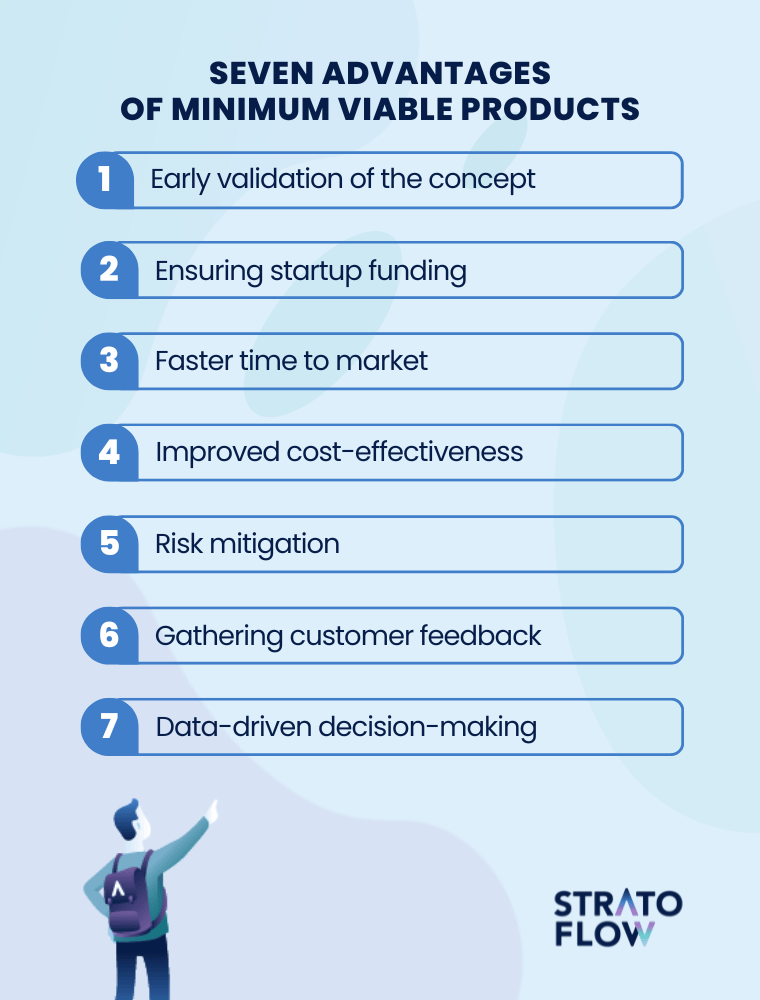
Early validation of the concept
Launching a minimum viable product allows startups to test their ideas quickly and cost-effectively.
It provides tangible evidence of whether there is a real demand for the product or service. This early validation helps startups avoid investing significant time and resources in a concept that might not resonate with the target audience.
Ensuring startup funding
MVPs are an attractive proposition for investors.
By demonstrating that you’ve taken concrete steps to validate your concept and that there is user interest, you increase your chances of securing funding. Investors are more likely to back a startup with a validated idea than one with only theoretical potential.
Faster time to market
Time is of the essence in the tech world. An MVP allows startups to get a basic version of their product in the hands of users much faster than developing a full-featured offering. This early entry into the market can help startups gain a competitive edge and capture early adopters.
Improved cost-effectiveness
By focusing on essential features, you can minimize development costs and allocate resources more efficiently. This reduces the financial risk associated with building a full-featured product from the outset. Iterative improvement
This cost-effectiveness ensures that startups can allocate their limited funds more efficiently, extending their runway and increasing their chances of survival.
Risk mitigation
Developing a complete product without user feedback is risky.
MVPs provide a safety net by allowing startups to test assumptions and gather feedback early. If the minimum viable product fails to gain traction, it’s much less costly than a full-fledged product, mitigating the financial risk associated with startups.
Gathering customer feedback
A minimum viable product enables startups to engage with real users who can provide valuable feedback. This feedback loop is instrumental in understanding user needs and preferences. It guides subsequent development efforts, ensuring that the product aligns with what customers truly want.
Data-driven decision-making
MVPs generate usage data and user feedback that drive informed decisions. Startups can rely on actual user behavior and preferences to prioritize future feature development. This data-driven approach minimizes guesswork and increases the likelihood of building a successful product.

Lean startup methodology – an answer to challanges of modern startups
When talkin about the importance and advantages of MVPs in product development we have to mention the leand startup methodology.
Lean Startup methodology is a systematic approach to building and growing startups by focusing on customer feedback, iterative development, and efficient use of resources. At its core, the Lean Startup methodology emphasizes the following key principles:
- Build-measure-learn,
- Validated learning,
- Continious feedback loop,
- Pivot or persevere,
- Lean thinking,
The Lean Startup methodology and the MVP concept are closely related.
An MVP is essentially the practical application of Lean Startup principles. By building a basic, functional version of their product and deploying it quickly, startups can efficiently validate or invalidate their assumptions.
The Lean Startup methodology and MVPs go hand-in-hand as powerful tools for startups to navigate the uncertain waters of entrepreneurship and ensure that they create products that are not only innovative, but also aligned with real customer needs and market demand.
[Read also: Launch Your Business to the Cloud: Enterprise Cloud Definition, Business Benefits and Key Solutions]
How to build Minimum Viable Product in Openkoda? Step by step process
Now that we know the theory, let’s look at how to build a successful MVP in a step-by-step process.
But we’re not going to build an MVP using a complicated and time-consuming method and tech stack. To build our minimum viable product, we will use Openkoda – an open-source low-code platform designed for building high performance enterprise applications and SaaS.
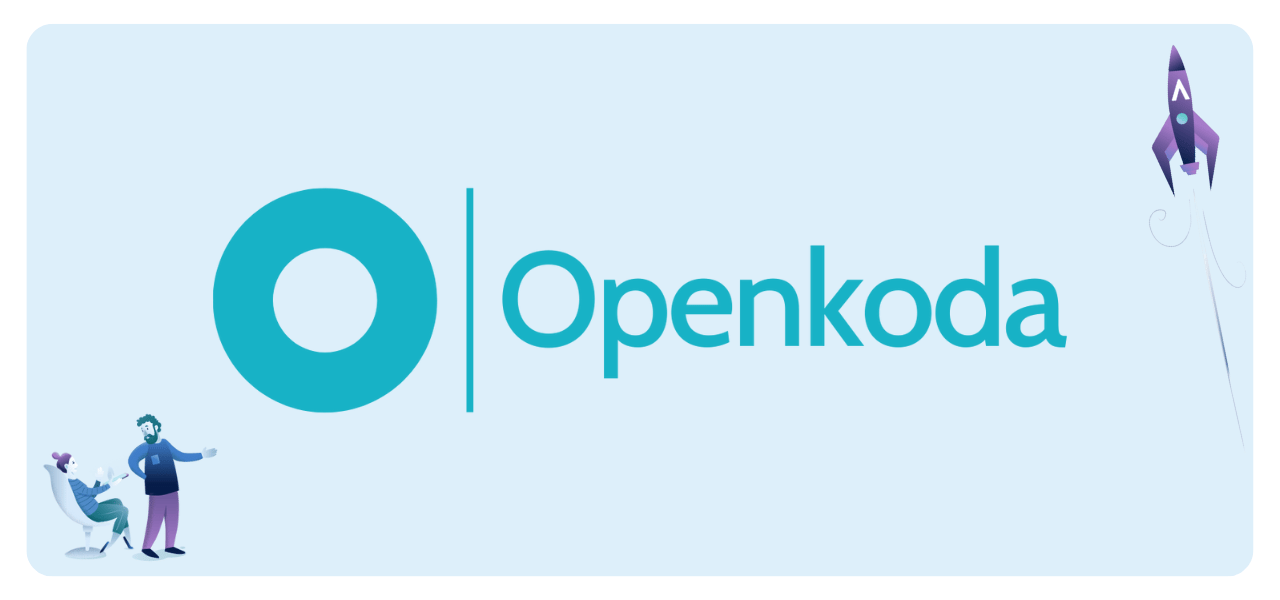
Why do we choose Openkoda for this particular task?
The answer is quite simple.
Whether we are using some sort of low-code platform or building an application prototype using a classic approach, MVPs are usually applications that are thrown together without worrying about things like cloud scalability and extensibility. After all, their main task is to prove the application’s core functionality. The time for serious development work comes later.
With Openkoda, we can create a working prototype of an application in record time, and if it succeeds – develop it into a full-fledged software product, introducing things like multi-tenant database solutions. It offers unparalleled scalability and extensibility without having to worry about vendor lock-in, thanks to its reliance on an open-source license.
That’s why it’s our go-to choice for building MVPs for our customers.
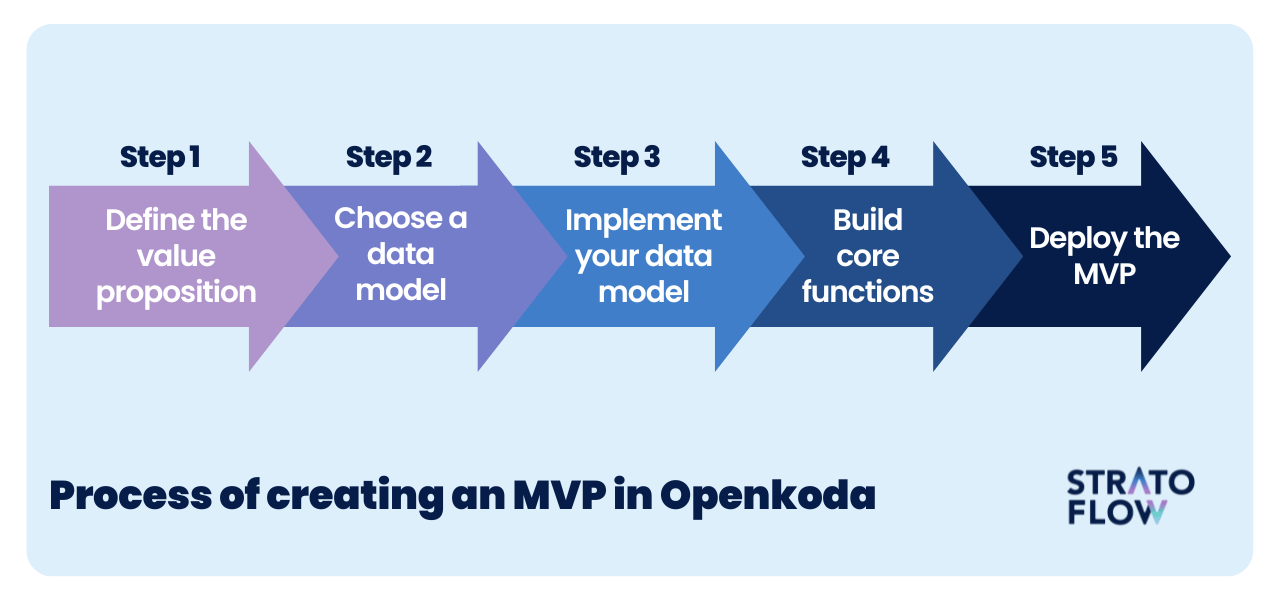
Step 1: Define the value proposition
First things first. Before we dive deeper into building a successful minimum viable product, we need to define a clear goal.
In this case, that will be the V in MVP – the value we want to deliver to our customers.
This value represents the core functionality of our application that will be responsible for generating the majority of our KPIs in the future.
Let’s say you’re building an accounting application. The minimum value in this case would be to provide users with a list of contractors and invoicing functionality.
By establishing a solid value proposition, the development team can focus on building features and functionality that directly address this core value. This ensures that the MVP addresses a real pain point in the market, increasing the likelihood of success and user adoption.
Step 2: Choose the right data model
Now comes the real work – designing a domain data model that fits into a designed MVP.
That’s where Openkoda’s first big advantage comes in. Openkoda actually delivers an out-of-the-box data model for generic SaaS products. All you have to do is think about the added value – you don’t have to worry about out-of-the-box entities, you just have to think through your unique business domain. In the case of our accounting application that we’ve mentioned, that would just be contractors and invoices themselves.
Coming up with a data model for an MVP is the part we should actually spend the most time and effort on when building a minimum value product in Openkoda.
Why?
If the MVP is successful, it will be the foundation for an entire application that will be built on top of it.
Step 3: Implement your data model
Implementing a data model involves a fairly standard mapping of a business model to a database within Openkoda. This means creating business objects in the database.
This may sound intimidating to someone with no technical knowledge, but don’t worry! This is a rather simple task that every software developer who had worked on enterprise apps should be familiar with. If we are talking about an MVP without a significantly large data model, this is a job for only a few hours for a single programmer.
And that’s basically all!
We’ve got an instance of Openkoda that we can use to input data into. So at this point we have a simple CRUD application. CRUD refers to the four basic operations that any software application should be able to perform – create, read, update, and delete. This application already has all the basic features of Openkoda and the ability to edit data from the model we created in step 2.
That’s another advantage of Openkoda – you can reach this CRUD level incredibly fast compared to classic development using standard frameworks like Spring.
Step 4: Build core functionalities
Now the fun part begins – developing the features that will deliver value to your users.
In Openkoda, you can speed up this process significantly using AI companion – an advanced AI tool designed to streamline the software development process by generating snippets of code as you work on your application. Of course, software developers can still build functionalities the old way – Openkoda just lets them focus on what really matters to end users.
The ultimate goal is to create a streamlined and functional version of the product that delivers on the promised value proposition. This doesn’t mean sacrificing quality. Clean, well-documented code and thoughtful design are paramount to ensuring that the MVP works as intended.
Step 5: Deploy an MVP
Now it’s time for what we’ve been waiting for – the final deployment.
The deployment phase marks the transition from development to real-world use, where the MVP’s true value is assessed by its users. It’s a critical step in building a successful product, and it sets the stage for continued development, refinement, and growth.
At this stage, you should consider early marketing initiatives to promote your MVP. You can create a landing page, launch a cold mailing campaign, or engage on social media according to your established user persona.
After you receive useful feedback, you can consider your MVP project a success. After that, you can decide whether you want to pursue this project, modify your vision in some way, or do something else entirely. The choice is up to you.
Conclusion
In conclusion, it is clear that MVPs are not just prototypes, but strategic cornerstones upon which successful products are built.
By focusing on early validation, cost-effectiveness, and user feedback, MVPs provide a clear path for entrepreneurs and product teams to navigate the complex landscape of the digital marketplace.
Related Posts
- Online Shopping Recommendations – How to Introduce Them in Your Business?
- Amazon Product Recommendation System: How Does Amazon’s Algorithm Work?
- Movie Recommendation System: How It Works And How To Introduce It In Your Business
- Your Guide to Property Management Software Development
- SDLC Guide: Best Strategies and Practices for Successful Software Deployment Phase
Thank you for taking the time to read our blog post!